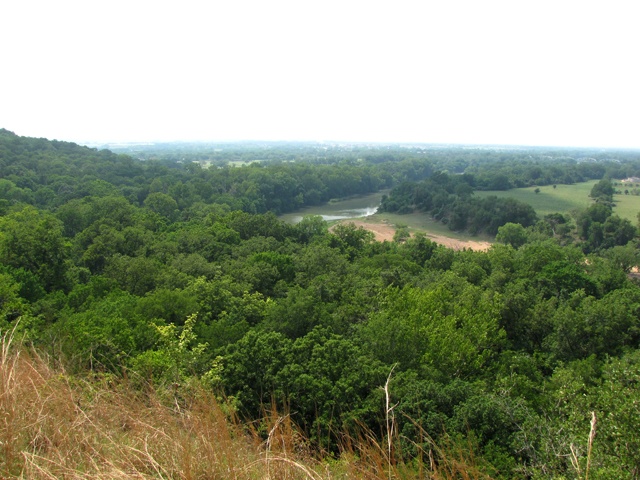Nothing creates lasting childhood memories quite like life’s simple pleasures. The red, plastic Igloo cooler with a crack across the top, chock-full of Mama’s homemade chicken salad sandwiches and icy Sun Crest sodas, made the trek each year to La Grange where Mama, Daddy and I settled under the shade of a live oak tree at historic Monument Hill. The little cooler’s bounty was spread on Grandma’s quilt, and the soda caps were popped, adding a new page to my heart’s scrapbook.
But the hands of time change everything, and recently I wondered just how much its grip had changed La Grange, the cozy, nostalgic Central Texas town of my yesteryear.
I returned to the Monument Hill and Kreische Brewery State Historic Sites which, under the supervision of the Texas Parks and Wildlife Department, sits on a sandstone bluff overlooking the winding Colorado River, one mile south of La Grange off U.S. Highway 77 on State Loop 92. Amid live oaks and abundant cedars, a granite tomb provides a resting place for 52 Texas soldiers killed by Mexican forces during the 1842 Dawson Massacre and the 1843 Black Bean Episode in which victims were chosen by lottery: The men who drew the 17 black beans from a jar of 176 beans were executed.
As I walked the crooked path to the monument, it seemed that time stood still. A glimpse to the right offered the historic, intact Kreische home, where German immigrant Heinrich Kreische and his wife, Josepha Appelt, raised six children. Everything was as I remembered. The cardinals still welcomed me, and a cool breeze still swept up from the river’s edge.
I recalled being a child of 7, scratching itchy, spindly, calamine lotion-slathered legs after blazing my own secret trail to the Kreische Brewery ruins. It was here, among the mountain laurel and mosquitoes, that the old brewmeister used the cool waters of the nearby spring to make his famous “Kreische’s Bluff Beer,” the last of which was brewed in 1884.
German and Czech heritage runs deep in Fayette County, known as the cradle of Czech immigration because more Austro-Hungarian Empire colonists settled there during the mid-to-late 19th century than any other place in Texas. On the grounds of the Texas Czech Heritage and Cultural Center, a gravel path led me through the Texas Czech Village, composed of mid-19th century houses. A brief stop at the Hoelscher Haus’ Polka Lovers of Texas Museum triggered memories of sitting on Grandpa’s gallery, a screened-in porch, with mid-August sweat dripping down my spine as the strains of “Beer Barrel Polka” drifted through the house.
Following the path, I passed the 1925 Fair Pavilion a historic building owned by the City of La Grange, whose sawdust-sprinkled hardwood floors have held up generations of schottische dancers.
Back in La Grange, home of Fayette Electric Cooperative, I passed The Bugle Boy an intimate concert hall that seats 80 within a World War II Army barrack. Steeped in nostalgia, the venue is named for The Andrews Sisters’ 1941 jump blues hit “Boogie Woogie Bugle Boy.”
I’ve sat quietly in the theater setting of this well-kept secret and listened as Paula Nelson, Willie Nelson’s spunky daughter, Austin blues and soul performer Woody Russell and folk music legend Janis Ian held their listeners spellbound during sold-out weekend concerts.
Making my way to historic downtown, I marveled at the beauty of the 1891 Romanesque Revival-style Fayette County courthouse designed by architect J. Riely Gordon. Nearby, on the northeast corner of the square, a gnarled, historic live oak tree stands in front of Prosperity Bank. The “muster” tree—so called because of the courage it symbolizes throughout the generations—marks the spot where families and sweethearts have met to tell their soldiers goodbye.
One block south of the square, I visited the “haunted” Fayette County Jail where the spirit of Marie Dach is said to reside. Rather than face electrocution, the defiant murderess of farmhand Henry Stoever starved herself to death, leaving behind three small children.
La Grange has seen its share of hard times, including the devastating floods of 1869 and 1913 and the yellow fever epidemic of 1867 that claimed 240 lives—about 20 percent of its total population.
And yet, its small-town charm prevails. Much has changed since my family picnics. Both parents are gone, and the little red cooler has long since been replaced. But I still have Grandma’s quilt—and Mama’s chicken salad recipe. Maybe I’ll share the quaint, historic town with the latest sprouts of the family tree.
I’ve got everything I need to add another page to my heart’s scrapbook … except that icy Sun Crest soda.
——————–
Connie Strong is a freelance writer based out of Chappell Hill, near Houston.









